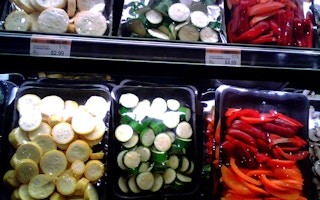You benefit from plastic from the moment you get up and use your toothbrush or kettle. Plastic is embedded in agriculture—and it keeps you alive if you end up in hospital. Even some of our money is made from it. Yet I can’t watch the news without being bombarded by the evils of plastic. As a polymer scientist, it feels like my life’s work is dismissed as immoral by even my hero Sir David Attenborough, simply because I deal with plastics.
But plastic itself is inanimate and cannot be evil—what’s morally wrong is what humans do with it.
But some plastic packaging does have benefits—even for the environment. Some packaging, for instance, prevents enough food waste (and therefore deforestation, fertiliser use or vehicle emissions) to balance out the inevitable litter. So how can you tell what is and isn’t worth it?
One reason this is so hard to figure out is down to the nature of the material itself. Different kinds of plastic have to be separated for recycling because they contain tiny building blocks that don’t mix at the molecular level. For instance, even many chemists don’t realise that polyethylene (PE) and polypropylene (PP) don’t mix, though they are the two of the most common forms of plastic and both have the same empirical formula of n(CH2). That’s why separating plastics at the recycling centre is so important.
A sports drink, for instance, can have three different and incompatible types of plastic in the bottle, the shrink-wrapped film, and the lid. All three components can be individually recycled but they are rarely separated other than by shredding.
Or look at black plastic trays. Their only function is to amplify the colour of a product, yet they also prevent recycling as sorting machines cannot detect black pigment.
In many cases, the packaging does have a genuine function and prevents waste by, for example, sealing in moisture or gas. But this can also mean certain thin films of plastic become impossible or prohibitively expensive to separate.
Packaged fruit and vegetables are egregious examples of excess plastic because they already come in a protective skin. Bananas already come in a perfectly designed wrapper—individuals can be snapped off a from a bigger pack, the skin splits length ways to expose the product, and it is truly biodegradable. Prepacked orange segments, meanwhile, last about four days whereas a whole orange can last months. Compare the environmental lifetime of orange peel (months) and polyethylene (effectively eternity)—all for the convenience of not peeling an orange. Such packaging serves little practical purpose, yet only a minority of supermarket fresh fruit and veg is offered “loose”.
Consumers are waking up to some of the worst excesses—see the recent furore over an M&S cauliflower steak that was pulled after complaints. But none of this is simple. Given that prepacked fruit and vegatables enable some disabled people to access fresh food, one person’s lazy and profligate is another’s lifesaver.
Durable plastic can be useful
So what can be done to reduce single-use plastic? A society that valued the environment over marketing could make evidence-based choices. On a larger scale, this involves policies such as the UK’s 5p carrier bag charge, which has driven an 80 per cent reduction in single-use bags.
But personal actions matter, too. Take the choices involved in a simple packed lunch of a falafel wrap, prepared at home. For the wrap, many advocate reusing aluminium foil rather than clingfilm. But foil has to be reused nearly 200 times to release less greeenhouse gases than clingfilm – 5g of aluminium versus 0.2g of film at six times more embedded energy and nine times more GHG per gram.
“
Single-use plastic is a complex issue—in some cases it is very useful, in others just the opposite. But consumers can make conscious choices, businesses can act responsibly and governments can enforce good policy to rid ourselves of pollution for profit.
Compare this to a reusable plastic sealed bag made from 14g of the same material as the clingfilm. This only needs to be used 70 times to get ahead (on GHG emmisions) of using new clingfilm every time, while there is no daily clingfilm or weekly foil going to landfill.
Or consider bottled water. The logical approach here is to reuse thicker bottles 100 times or more, but this may require a deposit scheme, collection and return, wash and refill—all of which costs. Thin single-use bottles are the lowest price, whereas refilling and reusing has the lowest environmental burden. Companies’ balance sheets and our pockets lead us to single-use plastics in the sea.
![]() Single-use plastic is a complex issue—in some cases it is very useful, in others just the opposite. But consumers can make conscious choices, businesses can act responsibly and governments can enforce good policy to rid ourselves of pollution for profit.
Single-use plastic is a complex issue—in some cases it is very useful, in others just the opposite. But consumers can make conscious choices, businesses can act responsibly and governments can enforce good policy to rid ourselves of pollution for profit.
Anthony J Ryan is Professor of Physical Chemistry and Director of the Grantham Centre for Sustainable Futures at the University of Sheffield. This article was originally published on The Conversation.


















